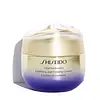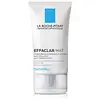What's inside
What's inside
 Key Ingredients
Key Ingredients

 Benefits
Benefits

 Concerns
Concerns

 Ingredients Side-by-side
Ingredients Side-by-side

Water
Skin ConditioningButylene Glycol
HumectantDimethicone
EmollientGlycerin
HumectantAlcohol Denat.
AntimicrobialPPG-3 Dipivalate
Skin ConditioningGlyceryl Stearate Se
EmulsifyingCetyl Alcohol
EmollientPentaerythrityl Tetraethylhexanoate
EmollientHydrogenated Polydecene
EmollientMyristyl Myristate
EmollientPEG-100 Stearate
Silica
AbrasiveBis-Diglyceryl Polyacyladipate-2
EmollientPotassium Methoxysalicylate
BleachingBehenyl Alcohol
EmollientSodium Acrylate/Sodium Acryloyldimethyl Taurate Copolymer
Emulsion StabilisingStearyl Alcohol
EmollientPolyvinyl Alcohol
Phenoxyethanol
PreservativeIsohexadecane
EmollientParfum
MaskingPolysorbate 80
EmulsifyingSorbitan Tristearate
EmulsifyingTrisodium EDTA
Erythritol
HumectantPEG/PPG-14/7 Dimethyl Ether
Skin ConditioningPEG/PPG-17/4 Dimethyl Ether
Skin ConditioningTocopheryl Acetate
AntioxidantRosa Damascena Flower Water
MaskingSodium Citrate
BufferingSuccinoglycan
Skin ConditioningAlcohol
AntimicrobialSorbitan Oleate
EmulsifyingCaffeine
Skin ConditioningCitric Acid
BufferingSodium Metaphosphate
BufferingLavandula Angustifolia Oil
MaskingPhytosteryl/Octyldodecyl Lauroyl Glutamate
Skin ConditioningLimonene
PerfumingHexyl Cinnamal
PerfumingTocopherol
AntioxidantLinalool
PerfumingCitronellol
PerfumingSodium Metabisulfite
AntioxidantCI 77492
Cosmetic ColorantAngelica Acutiloba Root Extract
Skin ConditioningAngelica Keiskei Leaf/Stem Extract
Skin ConditioningOlea Europaea Leaf Extract
PerfumingLamium Album Flower/Leaf/Stem Extract
Skin ConditioningCellulose
AbsorbentCamellia Sinensis Leaf Extract
AntimicrobialInositol
HumectantCarthamus Tinctorius Flower Extract
Skin ConditioningCI 77491
Cosmetic ColorantZiziphus Jujuba Fruit Extract
Skin ConditioningRosmarinus Officinalis Leaf Extract
AntimicrobialHydrolyzed Silk
HumectantBupleurum Falcatum Root Extract
Skin ConditioningWater, Butylene Glycol, Dimethicone, Glycerin, Alcohol Denat., PPG-3 Dipivalate, Glyceryl Stearate Se, Cetyl Alcohol, Pentaerythrityl Tetraethylhexanoate, Hydrogenated Polydecene, Myristyl Myristate, PEG-100 Stearate, Silica, Bis-Diglyceryl Polyacyladipate-2, Potassium Methoxysalicylate, Behenyl Alcohol, Sodium Acrylate/Sodium Acryloyldimethyl Taurate Copolymer, Stearyl Alcohol, Polyvinyl Alcohol, Phenoxyethanol, Isohexadecane, Parfum, Polysorbate 80, Sorbitan Tristearate, Trisodium EDTA, Erythritol, PEG/PPG-14/7 Dimethyl Ether, PEG/PPG-17/4 Dimethyl Ether, Tocopheryl Acetate, Rosa Damascena Flower Water, Sodium Citrate, Succinoglycan, Alcohol, Sorbitan Oleate, Caffeine, Citric Acid, Sodium Metaphosphate, Lavandula Angustifolia Oil, Phytosteryl/Octyldodecyl Lauroyl Glutamate, Limonene, Hexyl Cinnamal, Tocopherol, Linalool, Citronellol, Sodium Metabisulfite, CI 77492, Angelica Acutiloba Root Extract, Angelica Keiskei Leaf/Stem Extract, Olea Europaea Leaf Extract, Lamium Album Flower/Leaf/Stem Extract, Cellulose, Camellia Sinensis Leaf Extract, Inositol, Carthamus Tinctorius Flower Extract, CI 77491, Ziziphus Jujuba Fruit Extract, Rosmarinus Officinalis Leaf Extract, Hydrolyzed Silk, Bupleurum Falcatum Root Extract
Water
Skin ConditioningGlycerin
HumectantDimethicone
EmollientIsocetyl Stearate
EmollientAlcohol Denat.
AntimicrobialSilica
AbrasiveDimethicone Crosspolymer
Emulsion StabilisingAcrylamide
Sodium Acryloyldimethyltaurate Crosspolymer
Emulsion StabilisingVp/Va Copolymer
Methyl Methacrylate
Methyl Methacrylate Crosspolymer
Butylene Glycol
HumectantPEG-100 Stearate
Cocamide Mea
EmulsifyingSarcosine
Skin ConditioningGlyceryl Stearate
EmollientTriethanolamine
BufferingIsohexadecane
EmollientPerlite
AbsorbentCapryloyl Salicylic Acid
ExfoliatingTetrasodium EDTA
Pentylene Glycol
Skin ConditioningPolysorbate 80
EmulsifyingAcrylates/C10-30 Alkyl Acrylate Crosspolymer
Emulsion StabilisingSalicylic Acid
MaskingParfum
MaskingWater, Glycerin, Dimethicone, Isocetyl Stearate, Alcohol Denat., Silica, Dimethicone Crosspolymer, Acrylamide, Sodium Acryloyldimethyltaurate Crosspolymer, Vp/Va Copolymer, Methyl Methacrylate, Methyl Methacrylate Crosspolymer, Butylene Glycol, PEG-100 Stearate, Cocamide Mea, Sarcosine, Glyceryl Stearate, Triethanolamine, Isohexadecane, Perlite, Capryloyl Salicylic Acid, Tetrasodium EDTA, Pentylene Glycol, Polysorbate 80, Acrylates/C10-30 Alkyl Acrylate Crosspolymer, Salicylic Acid, Parfum
 Reviews
Reviews

Ingredients Explained
These ingredients are found in both products.
Ingredients higher up in an ingredient list are typically present in a larger amount.
Alcohol Denat. is an alcohol with a denaturant property. It is created by mixing ethanol with other additives.
This ingredient gets a bad rep because it is irritating and drying - mostly due to its astringent property. Astringents draw out natural oils in tissue, constricting pores and leaving your skin dried out.
However, alcohol denat. is not all that bad.
Due to its low molecular weight, alcohol denat. tends to evaporate quickly. One study on pig skin found half of applied alcohol evaporated in 10 seconds and less than 3% stayed on skin.
This also helps other ingredients become better absorbed upon application.
Studies are conflicted about whether this ingredient causes skin dehydration. One study from 2005 found adding emollients to propanol-based sanitizer decreased skin dryness and irritation. Another study found irritation only occurs if your skin is already damaged.
Small amounts of alcohol are generally tolerated by oily skin or people who live in humid environments.
The rule of thumb is if this alcohol is near the end of an ingredients list, it will probably not affect your skin much.
Also...
This ingredient has antimicrobial and solvent properties.
The antimicrobial property helps preserve products and increase their shelf life. As a solvent, it helps dissolve other ingredients.
Other types of astringent alcohols include:
Learn more about Alcohol Denat.Butylene Glycol (or BG) is used within cosmetic products for a few different reasons:
Overall, Butylene Glycol is a safe and well-rounded ingredient that works well with other ingredients.
Though this ingredient works well with most skin types, some people with sensitive skin may experience a reaction such as allergic rashes, closed comedones, or itchiness.
Learn more about Butylene GlycolDimethicone is a type of synthetic silicone created from natural materials such as quartz.
What it does:
Dimethicone comes in different viscosities:
Depending on the viscosity, dimethicone has different properties.
Ingredients lists don't always show which type is used, so we recommend reaching out to the brand if you have questions about the viscosity.
This ingredient is unlikely to cause irritation because it does not get absorbed into skin. However, people with silicone allergies should be careful about using this ingredient.
Note: Dimethicone may contribute to pilling. This is because it is not oil or water soluble, so pilling may occur when layered with products. When mixed with heavy oils in a formula, the outcome is also quite greasy.
Learn more about DimethiconeGlycerin is already naturally found in your skin. It helps moisturize and protect your skin.
A study from 2016 found glycerin to be more effective as a humectant than AHAs and hyaluronic acid.
As a humectant, it helps the skin stay hydrated by pulling moisture to your skin. The low molecular weight of glycerin allows it to pull moisture into the deeper layers of your skin.
Hydrated skin improves your skin barrier; Your skin barrier helps protect against irritants and bacteria.
Glycerin has also been found to have antimicrobial and antiviral properties. Due to these properties, glycerin is often used in wound and burn treatments.
In cosmetics, glycerin is usually derived from plants such as soybean or palm. However, it can also be sourced from animals, such as tallow or animal fat.
This ingredient is organic, colorless, odorless, and non-toxic.
Glycerin is the name for this ingredient in American English. British English uses Glycerol/Glycerine.
Learn more about GlycerinIsohexadecane is added to enhance texture, emulsify, and to help cleanse. It is an isoparrafin. It is a component of petrolatum.
Due to its large size, Isohexadecane is not absorbed by the skin. Instead, it sits on top and acts as an emollient. Emollients help keep your skin soft and smooth by trapping moisture within.
Isohexadecane is often used in products designed to help oily skin. It is lightweight and non-greasy while helping to moisturize. When mixed with silicones, it gives a product a silky feel.
Learn more about IsohexadecaneParfum is a catch-all term for an ingredient or more that is used to give a scent to products.
Also called "fragrance", this ingredient can be a blend of hundreds of chemicals or plant oils. This means every product with "fragrance" or "parfum" in the ingredients list is a different mixture.
For instance, Habanolide is a proprietary trade name for a specific aroma chemical. When used as a fragrance ingredient in cosmetics, most aroma chemicals fall under the broad labeling category of “FRAGRANCE” or “PARFUM” according to EU and US regulations.
The term 'parfum' or 'fragrance' is not regulated in many countries. In many cases, it is up to the brand to define this term.
For instance, many brands choose to label themselves as "fragrance-free" because they are not using synthetic fragrances. However, their products may still contain ingredients such as essential oils that are considered a fragrance by INCI standards.
One example is Calendula flower extract. Calendula is an essential oil that still imparts a scent or 'fragrance'.
Depending on the blend, the ingredients in the mixture can cause allergies and sensitivities on the skin. Some ingredients that are known EU allergens include linalool and citronellol.
Parfum can also be used to mask or cover an unpleasant scent.
The bottom line is: not all fragrances/parfum/ingredients are created equally. If you are worried about fragrances, we recommend taking a closer look at an ingredient. And of course, we always recommend speaking with a professional.
Learn more about ParfumPeg-100 Stearate is an emollient and emulsifier. As an emollient, it helps keep skin soft by trapping moisture in. On the other hand, emulsifiers help prevent oil and water from separating in a product.
PEGS are a hydrophilic polyether compound . There are 100 ethylene oxide monomers in Peg-100 Stearate. Peg-100 Stearate is polyethylene glycol ester of stearic acid.
Polysorbate 80 is a surfactant and emulsifier. It is used to keep ingredients together, and prevent oils and waters from separating.
It is made from polyethoxylated sorbitan and oleic acid. This ingredient can be found in cosmetics, foods, and medicine. It is water-soluble.
Polysorbate 80 may not be fungal acne safe.
Learn more about Polysorbate 80Silica, also known as silicon dioxide, is a naturally occurring mineral. It is used as a fine, spherical, and porous powder in cosmetics.
Though it has exfoliant properties, the function of silica varies depending on the product.
The unique structure of silica enhances the spreadability and adds smoothness, making it a great texture enhancer.
It is also used as an active carrier, emulsifier, and mattifier due to its ability to absorb excess oil.
In some products, tiny microneedles called spicules are made from silica or hydrolyzed sponge. When you rub them in, they lightly polish away dead skin layers and enhance the penetration of active ingredients.
Learn more about SilicaWater. It's the most common cosmetic ingredient of all. You'll usually see it at the top of ingredient lists, meaning that it makes up the largest part of the product.
So why is it so popular? Water most often acts as a solvent - this means that it helps dissolve other ingredients into the formulation.
You'll also recognize water as that liquid we all need to stay alive. If you see this, drink a glass of water. Stay hydrated!
Learn more about Water